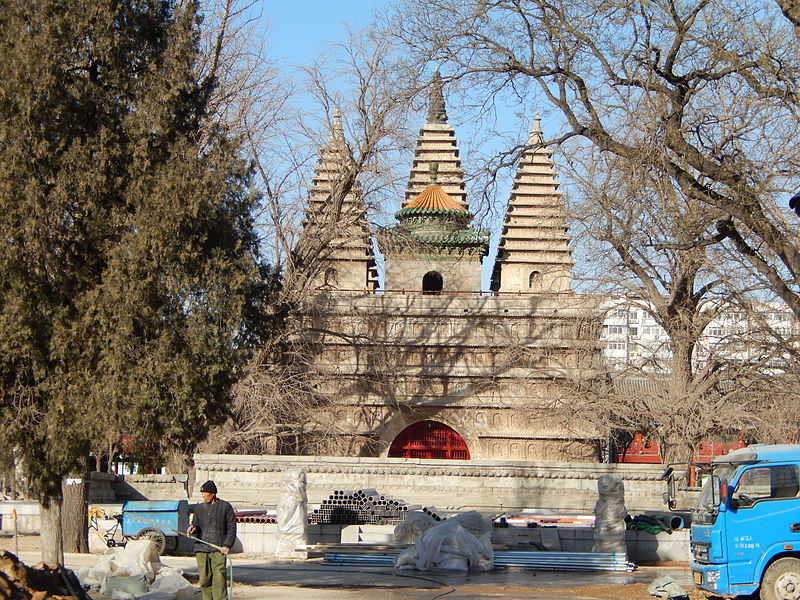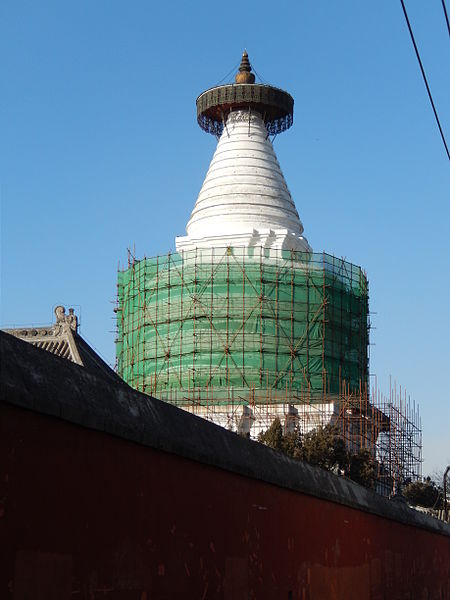Diary of a Rambling Antiquarian
Tuesday, 10 December 2013
Three Beijing Pagodas : Two out of Three
The Tangut conference concludes early and successfully at lunchtime on Tuesday, and as today is a clear sunny day, the smog swept away by a bitter north wind, I take off after lunch in search of my three pagodas. There are only a couple of hours until closing time, but I would like to cross off at least one the targets.
Five Pagodas Temple
The first, and most recent, pagoda on my list is within walking distance. It takes about twenty minutes from the hotel to reach the National Library, and from there just five minutes along a road hugging the river until the Five Pagodas Temple (五塔寺) is within sight. Properly known as the Temple of True Enlightenment (Zhenjue Temple 真覺寺), the temple was founded in the Ming dynasty, during the reign of the Chenghua Emperor (r. 1464–1487). The pagoda, built in 1473, is in the style of a "Diamond Throne Pagoda" (金剛寶座塔), loosely based on the model of the Mahabodhi Temple at Bodh Gaya in India, where Siddhartha Gautama is said to have attained enlightenment. A towering square foundation of rusty brown marble supports five marble and brick pagodas, four at the corners and one at the centre, each representing one of the Five Dhyani Buddhas. It is said that the temple's architect, an Indian monk called Pandida, brought with him five golden Buddha statues, and that one is buried beneath each pagoda, but if that were true I would probably have seen them at the Capital Museum on Sunday.
Save for the stone pagoda, all the temple buildings were destroyed during the turbulence of the late Qing, and the temple now houses the Beijing Art Museum of Stone Carvings (北京石刻藝術博物館). We approach the entrance, but the ticket office is closed, and a security guard tells us that the temple is closed for repairs. "Will it be open tomorrow?" I ask naively. "Tomorrow? Next year!" he replies. I can see the pagoda in the distance through the main gate fifty yards away, with workmen pushing wheelbarrows in and out, so I ask the security guard if we can at least go as far as the main gate to take a peek at the pagoda. He says "Yes" although his hands seem to indicate "No", which is good enough for me, and so despite his protesting hands we boldly march up to the gate, from where there is a reasonable view of the pagoda, even if we cannot see any of the detail of the carved decoration.
View of the Diamond Throne Pagoda from the main gate
White Pagoda Temple
Thanks to the closure of the Five Pagodas Temple there is still time to try for the second pagoda on my list. We head back to the main road, and down onto the subway. Four stops and one change of line, and we emerge at Fuchengmen station. A short walk east along the main street and the target comes into sight, a huge snow-white stupa-shaped pagoda rising up above the alleys and hutongs on the north side of the street. This is the Temple of Marvellous Response (Miaoying Temple 妙應寺), more commonly known as the Temple of the White Pagoda (白塔寺). The temple was founded during the Liao dynasty, in the 2nd year of the Shouchang era (1096), and was originally called the Temple of Eternal Peace (Yong'an Temple 永安寺). The temple was rebuilt during the Yuan dynasty, and renamed the Great Sage Longevity Ten Thousand Peace Temple (Dashengshou Wan'an Temple 大聖壽萬安寺). Its name was changed to the Temple of Marvellous Response during the Ming dynasty. The famous white pagoda was constructed during the Yuan dynasty, in the year 1271, under the direction of the Nepalese architect Araniko. This is the second oldest (or second most recent, depending on your point of view) of the three pagodas that I want to visit. Many relics were deposited in the pinnacle of the pagoda in 1753 by order of the Qianlong Emperor, and can presently be seen at the Capital Museum (see my first post in this series).
We head into a likely-looking alley, and are soon at what looks like the main entrance. But the entrance seems dead and abandoned, and the pagoda is wrapped in scaffolding and green netting. It does not look promising. With no-one at the entrance to ask, we continue along the alley around the pagoda, and immediately see a friendly-looking chap. "Where is the entrance to the temple?" I ask, and the answer is no suprise. "The entrance is just there", he says, indicating where we have just come from, "but the temple is closed for repairs". We circumambulate the pagoda in the wrong direction, and I try to get a decent picture.
View of the White Stupa-Pagoda from an alley east of the temple
The battery on my camera dies, and there would not have been time to reach the third pagoda on my list anyway, so somewhat disheartened we head back to the hotel.
Postscript
I returned to Beijing for two days in September 2017, and managed to visit the renovated and reopened White Stupa-Pagoda, as documented in this post.
Beijing | Ming dynasty | Pagodas | Stupas | Yuan dynasty
Index of Rambling Antiquarian Blog Posts
Rambling Antiquarian on Google Maps

